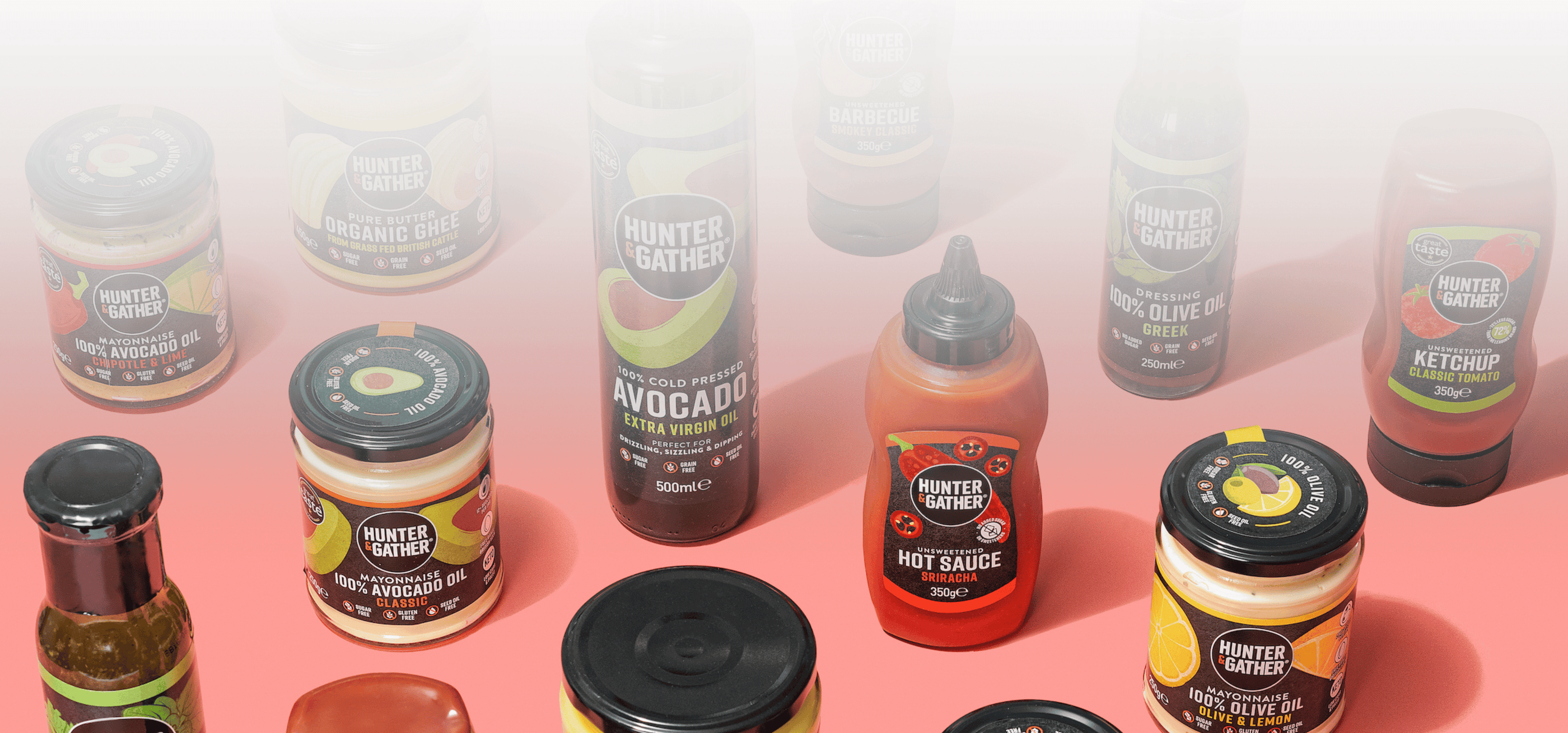Keto, Paleo and Low Carb are often used interchangeably when discussing diets, but there are actually some key differences between these lifestyles that you should know about to help you choose the best lifestyle for you.
Low Carb, Keto and Paleo: What is the difference?
There's no denying that there are some, if not many, commonalities between Low Carb, Keto and Paleo diets.
But whilst these eating templates may be built on the same foundations, there are some key differences which explain why they each have different names.
Understanding these can be really important when choosing the right lifestyle for you, as Keto, Paleo and Low Carb diets will have different benefits as well as wider considerations which go beyond what we eat.
In this article we will explore the similarities and differences of Low Carb, Keto and Paleo diets. To get started, here's a brief description of each:
-
Low Carb - A flexible diet which limits carbohydrate intake, cutting out foods which are high in carbs and resulting in a carb intake that is lower than typical. Total daily carb intake is usually less than 130g - around half that of the typical daily carb intake in the UK.
-
Keto - A diet which cuts out most sources carbohydrate, resulting in a carb intake that is incidental from other food groups. Total daily carb intake is typically lower than 50g and can be as low as or even lower than 20g. For most people, the aim of a Keto diet is to induce Ketosis, a fat-burning metabolic state which can only be achieved with a very low carb intake.
- Paleo - A diet which aims to include only food which would have been readily available to our hunter-gatherer ancestors - before the advent of agriculture some 10,000 years ago. Whilst there is no daily carbohydrate limit, the Paleo diet tends to be consequently low carb as it eliminates many foods which are high in carbohydrates.
Common Similarities Between Low Carb, Keto & Paleo Diets
There are multiple similarities between Keto, Low Carb and Paleo diets. This is why many people often get confused between the three, or presume they're all the same diet just with different names. Here are some aspects which all three diets have in common.
- Low in carbohydrates
You guessed it! Whether intentionally and in a measured sense, or incidentally due to eliminating certain foods, these three diets are all lower in carbohydrates compared with conventional diets.
Low Carb diets focus on keeping overall carbohydrate content lower than average - either by a little or a lot. Paleo diets do not allow any refined or processed carbs, which reduces daily intake significantly. Finally, Keto eating aims to be as close to "carb-free" as possible, so you don't go over your daily carb limit and does not involve any medium or high carb foods.
The good news is that for every carb-laden food, there is a Low Carb alternative which you can use to reinvent your favourite dishes.
👉 Check out our Low Carb, Keto & Paleo recipes
- A focus on minimally processed real food
One really important thing each of these diets has in common is that they all utilise fresh and natural foods, over processed and readymade foods.
Not only does this naturally drive down the carb content (as lots of processed foods contain refined carbs and added sugars), but it also makes for a diet that's rich in vitamins, minerals, fibre, healthy fats and protein - rather than artificial ingredients and additives.
Learn more about the benefits of choosing real, whole foods in our article below.
👉 Real food for real good health
- High in protein & healthy fats
Unlike carbohydrates, two nutrient group which feature predominantly in Low Carb, Keto and Paleo diets are protein and fat.
Each of these eating templates utilises animal-based proteins such as meat, fish and eggs, as well as nuts and seeds. They also include foods high in healthy fats such as butter, olive oil, avocado and - again - nuts & seeds.
With all of these diets, it's as much about what you do eat, as what you don't eat. Enjoying these foods daily is a great way to get the energy you need from food as well as a complete source of protein, vitamins, minerals and healthy fats.
- Closer to ancestral eating
Real foods are a lot more similar to that which our ancestors would have eaten and thrived on.
This is important because many modern lifestyles conditions are a consequence of the modern diet - and simply did not exist in ancestral times.
Whilst Low Carb and Keto diets are typically lower in processed foods, the Paleo diet is actually designed to help us to eat exactly as our hunter-gatherer ancestors did, to enjoy the health benefits. Learn more below.
👉 Adopting ancestral hacks to benefit a modern life
Key Differences Between Low Carb, Keto & Paleo Diets
Given their several similarities, it's clear to see why many people presume that Low Carb, Keto and Paleo lifestyles are all the same.
However, there are some important differences which set them apart. Understanding these can help you to choose the eating template which is best for you and your individual health goals.
Here are some important differences between Low Carb, Keto and Paleo lifestyles.
- Flexibility
Perhaps the most important differences between these diets is the extent to which they limit your carbohydrate intake.
For Low Carb diets, total daily carb intake is usually under 130g, whereas a Keto diet will keep carb intake less than 50g and as low as 20g per day. So a Low Carb diet is far more flexible and could include a variety of foods with a medium to high carbohydrate content. Whereas Keto eliminates all foods which have a more than incidental carb content.
Next up is Paleo, which does not dictate keeping carbs under a certain amount each day but is usually lower in carbs due to the foods it eliminates. Unlike Keto, you can include foods such as legumes, most fruit and starchy vegetables. As long as you stick to certain foods and avoid others, you don't need to think about carbohydrates or track your intake.
This brings us nicely on to our next point!
- Tracking your macros
If you've followed a Low Carb or Keto diet before then chances are you have some experience of tracking your macros.
Macro is short for macronutrients, a name given to nutrients we typically eat in large amounts such as protein, carbohydrate and fat - that is compared with micronutrients which you need in much smaller amounts, such as vitamins and minerals.
Using an app to calculate your macronutrient intake, or manually calculating these, is important to make sure that your daily carbohydrate intake is within the boundaries of your diet e.g. less than 50g daily for Keto and less than 130g for Low Carb.
Whilst all three diets eliminate high carb foods, carbohydrates are found in small amounts in most foods. As these can add up throughout the day it is best to track your macros if you would like to stay below a certain figure
In summary, for Low Carb and Keto you would need to track your macros if you were adhering to a strict diet, but with Paleo you don't necessarily have to.
- Health goals and benefits
Low Carb, Keto and Paleo lifestyles are all designed to improve overall health and wellness, but can each have some more specific health benefits.
If you like the sound of all three diets then you might like to think about which health outcomes you are striving for, together with the other considerations to help guide your choice.
For example, a Low Carb diet is a good way to manage weight maintenance but does not aim to create a state of Ketosis as Keto does - which has it's own benefits including improved insulin sensitivity and brain function.
And a Paleo diet embraces ancestral living as a whole, which has some unique benefits including reconnecting with nature, moving more and maintaining a sense of community.
Think of the health outcomes of each lifestyle as being on a sliding scale, with some being more effective than others for specific benefits - but all being great for overall health and wellness.
- Inclusion of Dairy
For some the thought of removing dairy completely from your lifestyle might sound like hell! With the paleo diet, dairy is a no go. No milk, cheese, cream or ice cream and switching to dairy free natural options like coconut milk or nut milks is key. Keto and Low Carb (although Milk Free, due to the high lactose sugar content) is not actually a dairy free lifestyle and you can include low carb/lactose options such as cheese and cream.
It's worth trying dairy free however if you have skin rashes, IBS etc and then gradually re-introduce. As many find that actually going dairy free via Paleo can be beneficial to their health.
- Wider lifestyle preferences
Aside from foods to eliminate and include, Low Carb, Keto and Paleo lifestyles each encompass some key factors beyond food. It is important to consider these when choosing the best diet for you in the long-term.
For example, as the Paleo diet embraces an ancestral eating template it encourages that there should be an emphasis on the source of foods. If they're heavily processed or contain even additives which aren't Paleo friendly, then they're off the menu. You should also aim to obtain animal products from their natural environment - such as grass fed beef, wild caught fish and free range eggs.
With Keto, the aim of the game is key: Ketosis. As it can be hard to know if you're in Ketosis or not, many people choose to monitor their blood sugar and ketone levels to be sure. You can learn more on this below.
👉 The best ketone testing methods & monitors
However, testing blood sugar or ketone levels is not something which would usually be necessary with Paleo or Low Carb.
Low Carb, Keto or Paleo - Which is Best?
Low Carb, Keto and Paleo diets have surprisingly just as many differences as they do similarities. Choosing the right eating template for you will depend on a number of factors, including food preferences, health goals and overall lifestyle. So, there is no right or wrong answer to this question.
One thing we do know for certain is that compared to conventional diets, eating a Low Carb, Keto or Paleo diet will be an invaluable part of any lifestyle in the pursuit of optimal health.
Always remember, consider which lifestyle you would like to follow in the long-term for every aspect it involves - rather than seeing Low Carb, Keto or Paleo as a quick fix or short-term diet.
All information provided on our website and within our articles is simply information, opinion, anecdotal thoughts and experiences to provide you with the tools to thrive.
It is not intended to treat or diagnose symptoms and is definitely not intended to be misconstrued for medical advice. We always advise you seek the advice of a trained professional when implementing any changes to your lifestyle and dietary habits.
We do however recommend seeking the services of a trained professional who questions the conventional wisdom to enable you to become the best version of yourself.
















